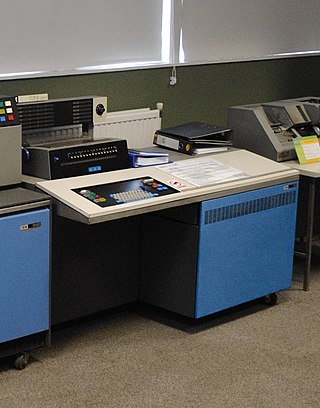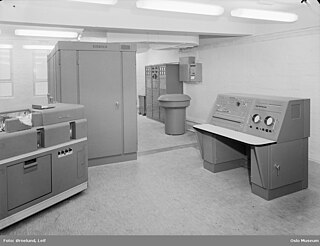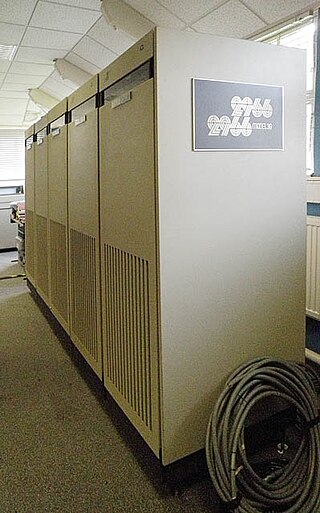Related Research Articles

The Data General Nova is a series of 16-bit minicomputers released by the American company Data General. The Nova family was very popular in the 1970s and ultimately sold tens of thousands of units.
A one-instruction set computer (OISC), sometimes referred to as an ultimate reduced instruction set computer (URISC), is an abstract machine that uses only one instruction – obviating the need for a machine language opcode. With a judicious choice for the single instruction and given arbitrarily many resources, an OISC is capable of being a universal computer in the same manner as traditional computers that have multiple instructions. OISCs have been recommended as aids in teaching computer architecture and have been used as computational models in structural computing research. The first carbon nanotube computer is a 1-bit one-instruction set computer.

The ERA 1101, later renamed UNIVAC 1101, was a computer system designed and built by Engineering Research Associates (ERA) in the early 1950s and continued to be sold by the Remington Rand corporation after that company later purchased ERA. Its (initial) military model, the ERA Atlas, was the first stored-program computer that was moved from its site of manufacture and successfully installed at a distant site. Remington Rand used the 1101's architecture as the basis for a series of machines into the 1960s.
MIX is a hypothetical computer used in Donald Knuth's monograph, The Art of Computer Programming (TAOCP). MIX's model number is 1009, which was derived by combining the model numbers and names of several contemporaneous, commercial machines deemed significant by the author. Also, "MIX" read as a Roman numeral is 1009.

The IBM 709 was a computer system, initially announced by IBM in January 1957 and first installed during August 1958. The 709 was an improved version of its predecessor, the IBM 704, and was the third of the IBM 700/7000 series of scientific computers. The improvements included overlapped input/output, indirect addressing, and three "convert" instructions which provided support for decimal arithmetic, leading zero suppression, and several other operations. The 709 had 32,768 words of 36-bit magnetic core memory and could execute 42,000 add or subtract instructions per second. It could multiply two 36-bit integers at a rate of 5000 per second.

An index register in a computer's CPU is a processor register used for pointing to operand addresses during the run of a program. It is useful for stepping through strings and arrays. It can also be used for holding loop iterations and counters. In some architectures it is used for read/writing blocks of memory. Depending on the architecture it may be a dedicated index register or a general-purpose register. Some instruction sets allow more than one index register to be used; in that case additional instruction fields may specify which index registers to use.

The IBM 1130 Computing System, introduced in 1965, was IBM's least expensive computer at that time. A binary 16-bit machine, it was marketed to price-sensitive, computing-intensive technical markets, like education and engineering, succeeding the decimal IBM 1620 in that market segment. Typical installations included a 1 megabyte disk drive that stored the operating system, compilers and object programs, with program source generated and maintained on punched cards. Fortran was the most common programming language used, but several others, including APL, were available.
The Simplified Instructional Computer is a hypothetical computer system introduced in System Software: An Introduction to Systems Programming, by Leland Beck. Due to the fact that most modern microprocessors include subtle, complex functions for the purposes of efficiency, it can be difficult to learn systems programming using a real-world system. The Simplified Instructional Computer solves this by abstracting away these complex behaviors in favor of an architecture that is clear and accessible for those wanting to learn systems programming.
Addressing modes are an aspect of the instruction set architecture in most central processing unit (CPU) designs. The various addressing modes that are defined in a given instruction set architecture define how the machine language instructions in that architecture identify the operand(s) of each instruction. An addressing mode specifies how to calculate the effective memory address of an operand by using information held in registers and/or constants contained within a machine instruction or elsewhere.

The DEUCE was one of the earliest British commercially available computers, built by English Electric from 1955. It was the production version of the Pilot ACE, itself a cut-down version of Alan Turing's ACE.
In computer engineering, an orthogonal instruction set is an instruction set architecture where all instruction types can use all addressing modes. It is "orthogonal" in the sense that the instruction type and the addressing mode vary independently. An orthogonal instruction set does not impose a limitation that requires a certain instruction to use a specific register so there is little overlapping of instruction functionality.

The ICL 2900 Series was a range of mainframe computer systems announced by the British manufacturer International Computers Limited on 9 October 1974. The company had started development under the name "New Range" immediately on its formation in 1968. The range was not designed to be compatible with any previous machines produced by the company, nor for compatibility with any competitor's machines: rather, it was conceived as a synthetic option, combining the best ideas available from a variety of sources.
NAR 1 or just NAR was a theoretical model of a computer created by Faculty of Mathematics of University of Belgrade professor Nedeljko Parezanović. It was used for Assembly language and Computer architecture courses.
NAR 2 is a theoretical model of a 32-bit word computer created by Faculty of Mathematics of University of Belgrade professor Nedeljko Parezanović as an enhancement to its predecessor, NAR 1. It was used for Assembly language and Computer architecture courses. The word "nar" means Pomegranate in Serbian. Many NAR 2 simulators have been created — for instance, one was named "Šljiva" as that fruit grows in Serbia, while "nar" does not.

The Elliott 803 is a small, medium-speed transistor digital computer which was manufactured by the British company Elliott Brothers in the 1960s. About 211 were built.
The Little Man Computer (LMC) is an instructional model of a computer, created by Dr. Stuart Madnick in 1965. The LMC is generally used to teach students, because it models a simple von Neumann architecture computer—which has all of the basic features of a modern computer. It can be programmed in machine code or assembly code.

The Apollo Abort Guidance System was a backup computer system providing an abort capability in the event of failure of the Lunar Module's primary guidance system during descent, ascent or rendezvous. As an abort system, it did not support guidance for a lunar landing.
The 12-bit ND812, produced by Nuclear Data, Inc., was a commercial minicomputer developed for the scientific computing market. Nuclear Data introduced it in 1970 at a price under $10,000.
The Hack Computer is a theoretical computer design created by Noam Nisan and Shimon Schocken and described in their book, The Elements of Computing Systems: Building a Modern Computer from First Principles. In using the term “modern”, the authors refer to a digital, binary machine that is patterned according to the von Neumann architecture model.
The City & Guilds Mnemonic Code and its associated City & Guilds Computer was a specification for an assembler language and a virtual computer system that ran it. It was introduced in 1964 by the City and Guilds of London Institute and used as the basis for a number of computer programming and administration courses. The computer model was deliberately very simple, and operational systems were implemented as interpreters on a number of mainframe computers like the ICL 1900 series and Elliot 900 family. An updated version was released in 1968.
References
- ↑ Computer Studies, page 71
- ↑ "ICL–CES: Computer Education in Schools". Archived from the original on 19 June 2021. Retrieved 16 June 2021.
- ↑ Furber, Steve (January 2012). "Appendix J: Timeline of major developments in Computing in schools in England". Shut down or restart? The way forward for computing in UK schools (PDF). The Royal Society. p. 120. Archived (PDF) from the original on 2021-05-06. Retrieved 20 June 2021.
- 1 2 3 4 Computer Studies, page 72
- ↑ "My First Program". Archived from the original on 24 June 2021. Retrieved 16 June 2021.
- ↑ Computer Studies, page 82
- ↑ Computer Studies, page 76
- 1 2 Computer Studies, pages 93–94
- 1 2 Computer Studies, page 148
- 1 2 Computer Studies, page 77
- 1 2 Computer Studies, page 74
- ↑ Computer Studies, pages 96, 148
- ↑ Computer Studies, pages 97–99
- ↑ Computer Studies, page 201
- 1 2 3 Computer Studies, page 73
- ↑ Computer Studies, pages 199–200
- ↑ Computer Studies, pages 80, 97–98
- ↑ Computer Studies, pages 84, 97–98
- ↑ Computer Studies, pages 86, 97–98
- ↑ Computer Studies, pages 90, 97–98
- ↑ Computer Studies, pages 92, 97–98
- ↑ Computer Studies, page 145
- ↑ Computer Studies, page 198
- ↑ Computer Studies, page 154
- ↑ Computer Studies, page 83
- ↑ Computer Studies, page 164
- ↑ Andrew John Jacobs (20 June 2010). "Visual CESIL". Archived from the original on 12 September 2021. Retrieved 26 November 2021.
- ↑ Wyrm Software (13 October 2019). "Wyrm CESIL". Archived from the original on 25 November 2021. Retrieved 25 November 2021.